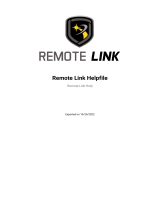
Digital Monitoring Products XR150/XR550 Canadian Series Programming Guide
vi
TABLE OF CONTENTS
16.9 Early Morning Ambush (Network panels only) ................................................................ 42
16.10
Area Number ............................................................................................................... 42
16.10.1
All/Perimeter Programming ........................................................................................... 42
16.10.2
Home/Sleep/Away Programming ................................................................................... 42
16.11 Area Name .................................................................................................................. 42
16.12 Account Number .......................................................................................................... 42
16.13 Automatic Arming ........................................................................................................ 43
16.14 Bad Zones ................................................................................................................... 43
16.15 Automatic Disarming .................................................................................................... 43
16.16 Armed Output Number ................................................................................................. 43
16.17 Late Output Number .................................................................................................... 43
16.18 Late Arm Delay............................................................................................................ 43
16.19 Bank Safe & Vault (XR550 with Network or Encryption only) ........................................... 43
16.20 Common Area ............................................................................................................. 43
16.21 Arm First Area ............................................................................................................. 43
16.22 Dual Authority (XR550 with Network or Encryption only) ................................................ 44
16.23 Card Plus Pin (XR550 with Network or Encryption only) .................................................. 44
Zone Information ..........................................................................................45
17.1 Zone Information ......................................................................................................... 45
17.2 Zone Number .............................................................................................................. 45
17.3 Zone Name ................................................................................................................. 45
17.4 Zone Type ................................................................................................................... 45
17.5 Area Assignment ......................................................................................................... 46
17.6 Fire Bell Output ........................................................................................................... 46
17.7 Arming Zone Area Assignment ...................................................................................... 46
17.8 Style ........................................................................................................................... 47
17.9 Expander Serial Number............................................................................................... 47
17.10 Next Zone ................................................................................................................... 47
DMP Wireless ............................................................................................................. 47
17.11 Wireless ...................................................................................................................... 47
17.11.1 Serial Number Entry..................................................................................................... 47
17.11.2 Contact ....................................................................................................................... 48
17.11.3 Supervision Time ......................................................................................................... 48
17.11.4 LED Operation ............................................................................................................. 48
17.11.5 Disarm/Disable ............................................................................................................ 48
17.11.6 PIR Pulse Count .......................................................................................................... 48
17.11.7 PIR Sensitivity ............................................................................................................. 48
17.11.8 Pet Immunity .............................................................................................................. 49
17.11.9 Next Zone ................................................................................................................... 49
17.12 1144 Series Key Fobs ................................................................................................... 49
17.12.1 Key Fob User Number .................................................................................................. 49
17.12.2 Key Fob Serial Number ................................................................................................. 49
17.12.3 Key Fob Supervision Time ............................................................................................ 49
17.12.4 Number of Key Fob Buttons .......................................................................................... 49
17.12.5 Key Fob Button Selection (Four Buttons) ....................................................................... 49
17.12.6 Key Fob Button Selection (Two Buttons) ........................................................................ 49
17.12.7 Button Action .............................................................................................................. 49
17.12.8 Button Press Time ....................................................................................................... 50
17.12.9 Arm/Disarm Area Selection ........................................................................................... 50
17.12.10 Output Number ........................................................................................................... 50
17.12.11 Output Action .............................................................................................................. 50
17.12.12 Next Zone ................................................................................................................... 51
17.13 Alarm Action ............................................................................................................... 51
17.14 Disarmed Open ........................................................................................................... 51
17.15 Report to Transmit ....................................................................................................... 51
17.16 Output Number ........................................................................................................... 52
17.17 Output Action .............................................................................................................. 52
17.18 Swinger Bypass ........................................................................................................... 52
17.19 Prewarn Keypad Addresses........................................................................................... 52


































